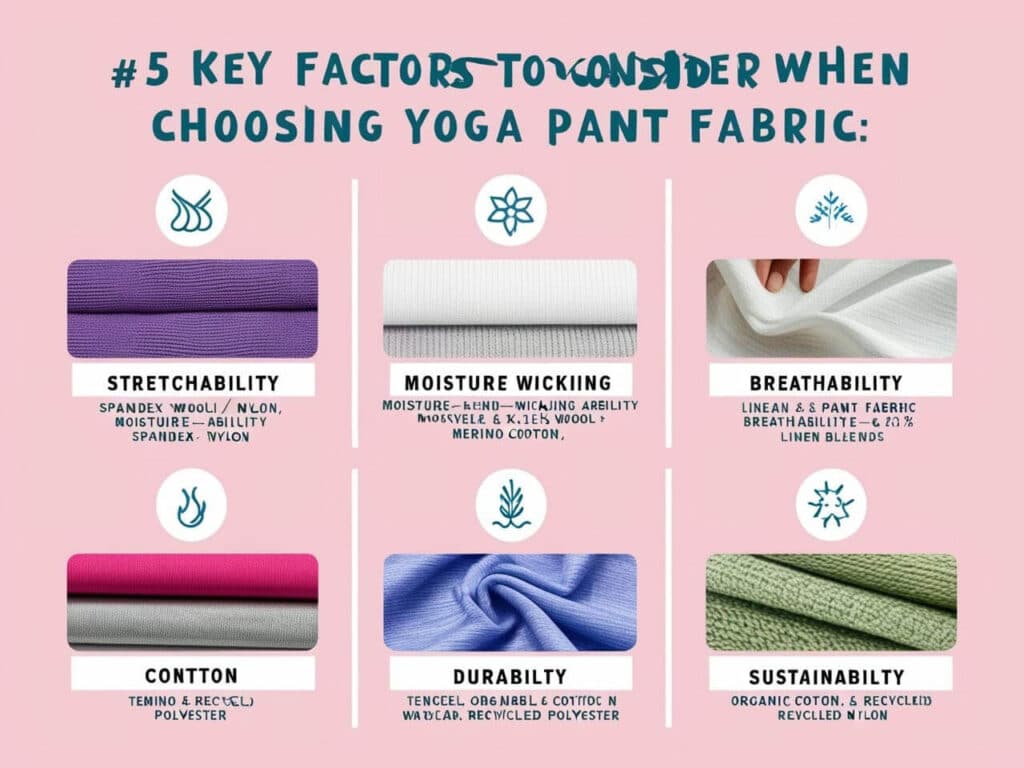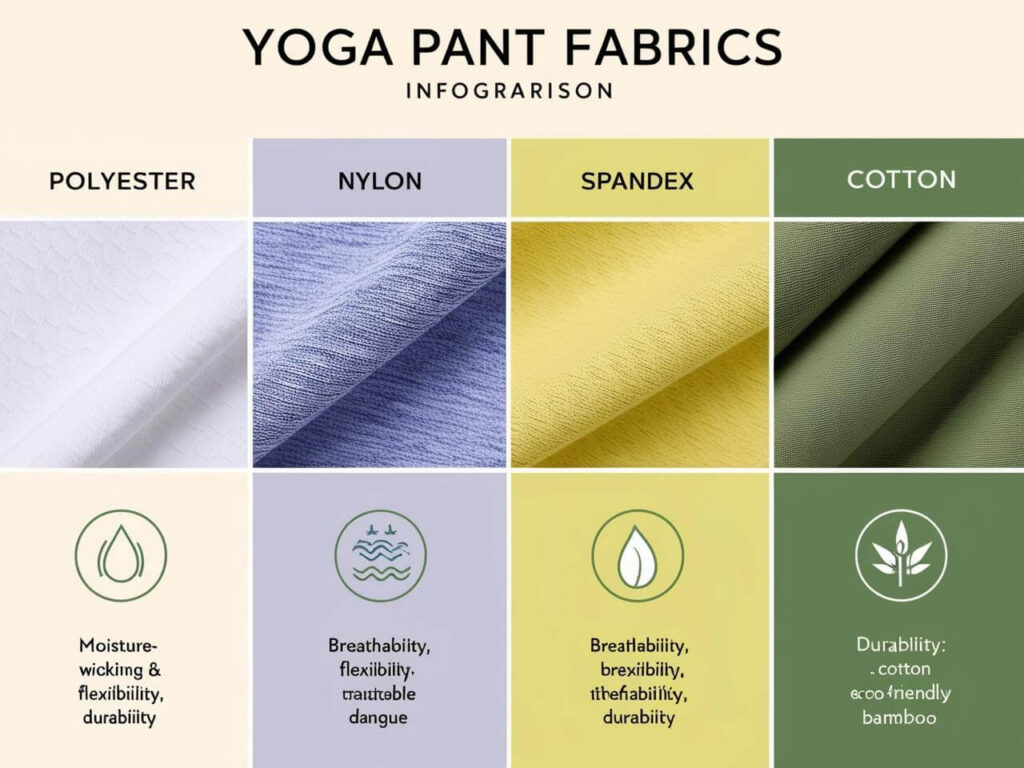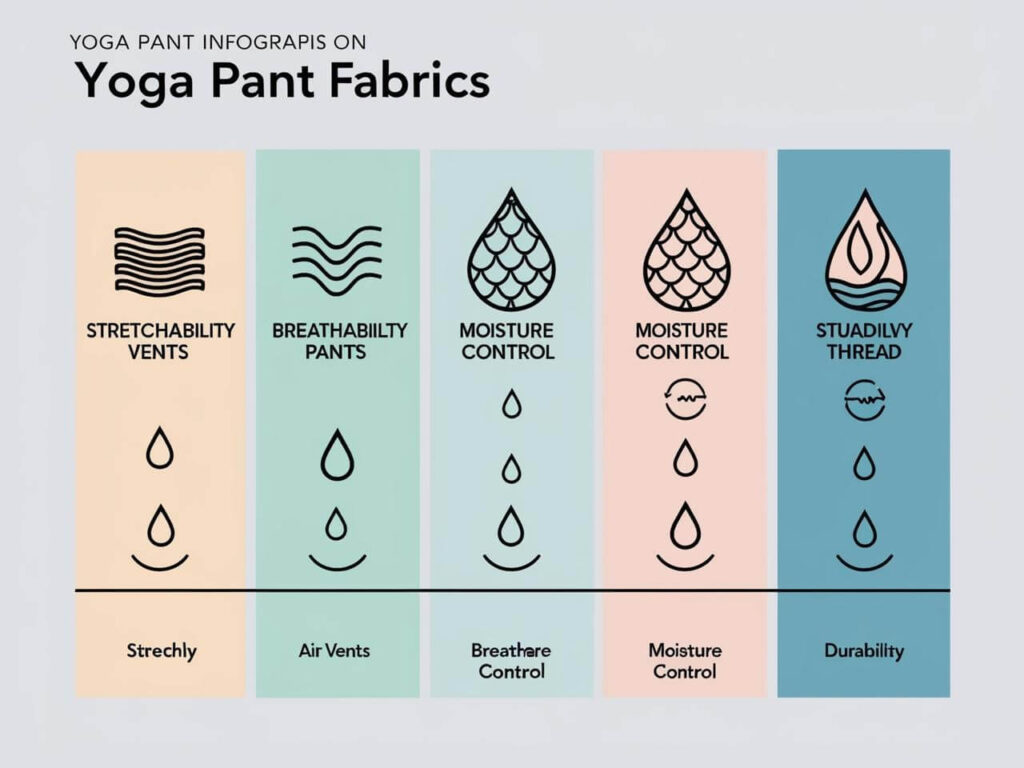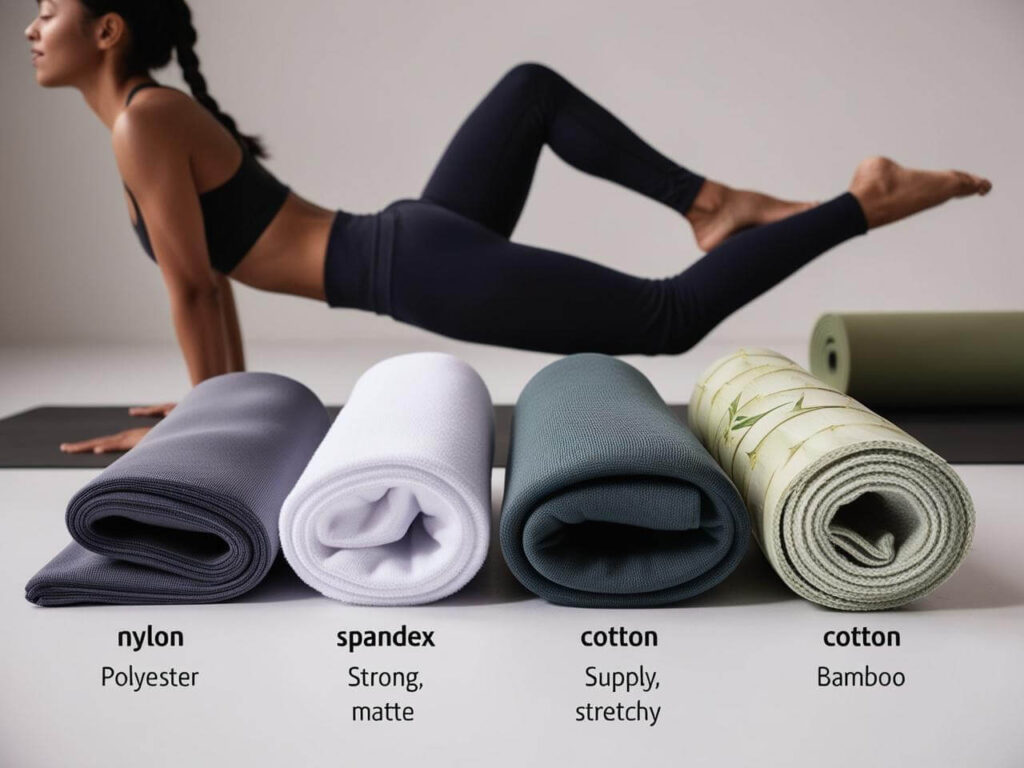Introduction
The fabric of your yoga pants can make or break your practice. Whether you’re flowing through a Vinyasa sequence or holding a deep stretch in Yin yoga, the right material enhances movement, wicks away sweat, and provides long-lasting comfort.
I’ve tested multiple yoga pant fabrics, and I’ve learned that some materials are better suited for flexibility and breathability, while others offer durability and moisture control. So, what’s the best fabric for yoga pants?
In this guide, you’ll discover:
✔ The top yoga pant fabrics and their key features.
✔ Which materials are best for hot yoga, gentle yoga, and everyday wear.
✔ Eco-friendly options like bamboo and recycled polyester.
No matter your yoga style, let’s find the best fabric for your perfect stretch!
Key Factors to Consider When Choosing Yoga Pant Fabric

Choosing the right fabric for yoga pants affects flexibility, breathability, and comfort. Here are the key factors to consider:
1️⃣ Stretch & Flexibility 🤸♀️
✔ Why it matters: Yoga involves dynamic movements and deep stretches, so your fabric must move with you.
✔ Best fabrics: Spandex (Lycra), nylon, and polyester blends offer the best 4-way stretch.
✔ Worst fabrics: 100% cotton lacks elasticity and can restrict movement.
2️⃣ Moisture-Wicking Ability 💦
✔ Why it matters: Sweat can make yoga pants feel heavy and uncomfortable, especially during hot yoga or intense flows.
✔ Best fabrics: Polyester and bamboo wick moisture away and dry quickly.
✔ Worst fabrics: Cotton absorbs sweat but dries slowly, making it less ideal for sweaty sessions.
3️⃣ Breathability 🌬
✔ Why it matters: Good airflow prevents overheating and helps regulate body temperature.
✔ Best fabrics: Bamboo, nylon, and polyester blends allow air to circulate.
✔ Worst fabrics: Thicker cotton blends may trap heat and feel restrictive.
4️⃣ Durability & Shape Retention 🏋️♀️
✔ Why it matters: Frequent washing and stretching can wear down fabric quality over time.
✔ Best fabrics: Polyester and spandex blends maintain their shape even after multiple washes.
✔ Worst fabrics: Pure cotton tends to shrink and lose shape.
5️⃣ Sustainability & Eco-Friendly Choices 🌿
✔ Why it matters: More brands are turning to sustainable yoga pants to reduce environmental impact.
✔ Best fabrics: Bamboo, organic cotton, and recycled polyester (Repreve®) are top eco-friendly choices.
✔ Worst fabrics: Traditional polyester and synthetic materials are made from fossil fuels.
Best Fabrics for Yoga Pants (Pros & Cons)

Different fabrics offer varying levels of comfort, stretch, and durability. Below is a breakdown of the best materials for yoga pants and their advantages.
1️⃣ Polyester – The Moisture-Wicking Champion
✔ Keeps you dry with excellent moisture-wicking properties.
✔ Durable & wrinkle-resistant, maintaining its shape.
✔ Often blended with spandex for added stretch.
🔻 Can retain odors over time if not properly cared for.
📌 Best for: Sweaty yoga sessions, high-intensity flows, and hot yoga.
2️⃣ Nylon – Soft, Lightweight & Stretchable
✔ Super soft & breathable, making it comfortable for all-day wear.
✔ Excellent stretch & flexibility, allowing full-body movement.
✔ Quick-drying and moisture-wicking.
🔻 Less resistant to chlorine and heat compared to polyester.
📌 Best for: Restorative yoga, casual wear, and studio practice.
3️⃣ Spandex (Lycra/Elastane) – Maximum Flexibility
✔ 4-way stretch provides unrestricted movement.
✔ Blended with polyester or nylon for improved comfort.
✔ Retains shape after multiple washes.
🔻 Not moisture-wicking on its own and needs to be blended.
📌 Best for: Yoga styles requiring high flexibility (e.g., Vinyasa, Ashtanga yoga).
4️⃣ Cotton – Soft & Natural, But Less Durable
✔ Naturally soft and breathable for a comfortable feel.
✔ Eco-friendly when using organic cotton.
🔻 Absorbs sweat and dries slowly, making it less ideal for intense yoga.
📌 Best for: Gentle yoga, meditation, and light stretching.
5️⃣ Bamboo Fabric – The Sustainable Choice
✔ Naturally moisture-wicking and antibacterial.
✔ Eco-friendly and biodegradable.
✔ Super soft and breathable.
🔻 Less durable than synthetic fabrics and can lose shape over time.
📌 Best for: Eco-conscious yogis & those with sensitive skin.
🔗 External Resource:
Yoga Pant Fabric Comparison Table

To help you compare different yoga pant fabrics, here’s a detailed side-by-side breakdown of their key properties.
| Fabric | Stretchability | Breathability | Moisture-Wicking | Durability | Best For |
| Polyester | ✅ High | ⚠️ Medium | ✅✅ Excellent | ✅ High | Sweaty workouts, hot yoga |
| Nylon | ✅✅ Excellent | ✅ High | ✅ High | ✅ High | Stretch-focused yoga, casual wear |
| Spandex | ✅✅ Maximum | ✅ High | ⚠️ Low | ✅ High | Extreme flexibility workouts |
| Cotton | ⚠️ Medium | ✅✅ Excellent | ❌ Low | ⚠️ Medium | Gentle yoga, meditation |
| Bamboo | ✅ High | ✅✅ Excellent | ✅ High | ⚠️ Medium | Sustainable & skin-friendly yoga wear |
🔗 External Resource:
FAQs (People Also Ask)
Here are answers to some of the most frequently asked questions about yoga pant fabrics, based on Google’s “People Also Ask” section.
❓ What is the best fabric for yoga pants?
✔ Polyester and nylon are the most popular choices due to their stretch, moisture-wicking properties, and durability.
❓ Are cotton yoga pants good?
✔ Cotton is soft and breathable, but it absorbs sweat and dries slowly, making it less ideal for high-intensity yoga.
❓ What fabric is best for hot yoga?
✔ Moisture-wicking polyester blends keep you dry and comfortable during sweaty hot yoga sessions.
❓ Do yoga pants need spandex?
✔ Yes! Spandex (Lycra) provides elasticity, allowing yoga pants to move freely with your body.
❓ What is the most eco-friendly yoga pant fabric?
✔ Bamboo and recycled polyester are great sustainable options for eco-conscious yogis.
Choosing the Best Fabric for Your Yoga Pants
The right fabric for yoga pants can enhance your practice by improving flexibility, comfort, and durability. Whether you prefer a moisture-wicking material for hot yoga or a soft, sustainable option for gentle flows, the right choice makes all the difference.
✔ Key Takeaways:
- Polyester & Nylon – Best for sweaty workouts, moisture control, and durability.
- Spandex – Provides maximum stretch, ideal for high-movement yoga styles.
- Cotton – Soft and breathable but less effective at moisture control.
- Bamboo – A sustainable choice that is naturally antibacterial and comfortable.
✔ Final Tips:
- If you sweat a lot, go for moisture-wicking polyester blends.
- If you need maximum flexibility, choose pants with high spandex content.
- For an eco-friendly option, look for bamboo or recycled polyester yoga pants.
Final Thoughts
Yoga pants should feel like a second skin, allowing you to move freely and stay comfortable. By understanding the benefits of each fabric, you can make an informed choice that suits your yoga practice and lifestyle.
